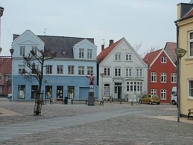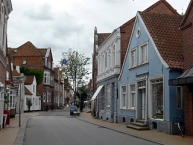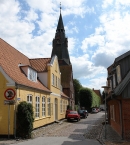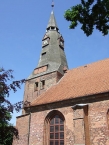Tønder
Worth visiting
Added on 12 Jul 2013,
last edited by Ottocolor on 12 Jul 2013
Nearby cycle routes and tours
| Route name | Type | Dist. to route |
|---|---|---|
Route | 0,0 km | |
Route | 0,2 km | |
Tour | 0,0 km | |
Tour | 0,2 km | |
Tour | 4,2 km |
![]()
Please wait - map data are loading
Type of sights
Old town
Name and address
Tønder
DK-6270 Tønder
GEO-data
Geodetic coordinates
54.93∎∎∎∎ 8.86∎∎∎∎
Elevation
5 m
Communication
Phone
+45 ∎∎ ∎∎∎∎∎∎
Internet
∎∎∎.∎∎∎∎∎∎∎.∎∎/
∎∎∎∎∎∎∎@∎∎∎∎∎∎∎.∎∎
Information about copyright | |
|---|---|
Rights owner | Clemensfranz |
Rights characteristic / license | by-sa: CREATIVE COMMONS Attribution-ShareAlike |
Link to the description of the license | |
Image taken over from | |
Image has been uploaded | by Ottocolor on 12 Jul 2013
|
Information about copyright | |
|---|---|
Rights owner | Wolfgang Sauber |
Rights characteristic / license | by-sa: CREATIVE COMMONS Attribution-ShareAlike |
Link to the description of the license | |
Image taken over from | |
Image has been uploaded | by Ottocolor on 12 Jul 2013
|
Information about copyright | |
|---|---|
Rights owner | Jürgen Howaldt |
Rights characteristic / license | by-sa: CREATIVE COMMONS Attribution-ShareAlike |
Link to the description of the license | |
Image taken over from | |
Image has been uploaded | by Ottocolor on 12 Jul 2013
|
Information about copyright | |
|---|---|
Rights owner | Achim Strehlke |
Rights characteristic / license | by-sa: CREATIVE COMMONS Attribution-ShareAlike |
Link to the description of the license | |
Image taken over from | |
Image has been uploaded | by Ottocolor on 12 Jul 2013
|
Tønder (German: Tondern) is a Danish town in the Region of Southern Denmark with a population of 7,572 (1 January 2013). It is the main town and the administrative seat of Tønder Municipality.
During World War I, a base for Zeppelin airships was operated at Tønder by the German Navy
. The former site now houses a museum, the Zeppelin and Garrison Museum Tønder. The base was attacked by the British on 19 July 1918, during what is known as theTondern raid
. Seven Sopwith Camels
from the aircraft carrier HMS Furious
bombed the base and two of the three Airship hangars
were hit, the Zeppelins L.54 and L.60 inside one hanger were destroyed and a balloon inside the other was damaged. After this, Tondern was abandoned as an active airship base, and ordered to be used only as an emergency landing site. A wartime aircraft hangar survives, as do some of the ancillary buildings from the period, but only the foundations remain of the large airship hangars.
After the First World War, Tønder was detached from Germany even though 77% of the voters had voted to remain with the German Empire in the Schleswig Plebiscites . In the following years German political parties had a majority in the city council. Until 1945, the city was officially bilingual. During World War II, Tønder was the place where the German forces crossed the border to occupy Denmark. Later, Tønder came to host a small, German concentration camp (see Tønder concentration camp). Shortly after the re-establishment of the Danish administration Tønder was the site of a garrison.
After the end of the German occupation in World War II, the political significance of the German part of the population dwindled considerably. The border situation hindered the development of the city. Nevertheless, some companies settled. The importance of tourism increased. Despite the improvement of cross-border traffic, the location was in the late 20th Tønders Century increasingly difficult. In 1989, a teacher training college opened its doors in 2002, the barracks and in the following year the hospital, which is, however, now been enhanced as a private clinic again.
Attractions
Every August, the Tønder Festival offers visitors a wide variety of traditional and modern folk music. The Scouts of Tonder are twinned with Hemyock
, in Devon, England, and the scouts make exchange trips every few years.
Information about copyright | |
|---|---|
Rights characteristic / license | by-sa: CREATIVE COMMONS Attribution-ShareAlike |
Link to the description of the license | |
Input taken over from: |
Tønder. (2013, June 28). In Wikipedia, The Free Encyclopedia. Retrieved 13:52, July 12, 2013, fromhttp://en.wikipedia.org/w/index.php?title=T%C3%B8nder&oldid=561974030 |
taken over / edited on | 12 Jul 2013
|
taken over / edited by |
|
Nearby cycle routes and tours
| Route name | Type | Dist. to route |
|---|---|---|
Route | 0,0 km | |
Route | 0,2 km | |
Tour | 0,0 km | |
Tour | 0,2 km | |
Tour | 4,2 km |
Added on 12 Jul 2013,
last edited by Ottocolor on 12 Jul 2013




